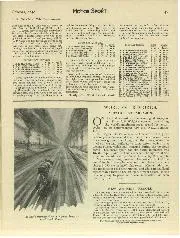
ATTACKS AT ARPAJON
WORLD'S RECORDS. ATTACKS AT ARPAJON. oN the 31st August at the meeting at Aspajon, near Paris, J. S. Wright succeeded in regaining the world's maximum speed record for motorcycles, on…
THE REAPPEARANCE OF A FAMOUS BRITISH SPORTS CAR. The New Aston-Martin.
ONE frequently hears it asserted that there is at least one class of sports car, which had its founation in this country, and in which England has always led, namely the 1500 c.c. class machine ; and it is equally certain that one of the cars which has done most to build up this reputation is the Aston-Martin.
For the past year or so, the production of these cars has been in abeyance, and it was therefore with pleasure that enthusiasts realised at this Olympia Show, that their makers had only decided to “se reculer pour mieux sauter,” and that an entirely new Aston-Martin was now going to be offered to the sports car enthusiast.
We recently had the pleasure of being shown over the new factory at Feltham, Middlesex, where these cars are now made, by Mr. J. R. Benson, who is one of the designers of the new model. The new works are very much more commodious than the old Aston-Martin premises in Kensington, and make possible the production of the car on a sufficiently large scale to bring its price within the scope of a greater number of buyers than formerly, while each car still obtains that individual attention which is so essential for a machine designed for a discriminating class of motorist as opposed to those who simply regard a car as a convenient means of locomotion.
As the car has been shown at Olympia the main points of its specification are probably known to most of our readers, and we need, therefore, only point out some features which were shown us, and which may have escaped attention. The new model has a 4-cylinder engine of 69 x 99 mms. bore and stroke, giving a capacity of 1481 c.c. Unlike the old engine, which obtained its remarkable efficiency with the use of side valves, the new one has its valves overhead, operated by a single chain-driven overhead camshaft and rockers. The valves, of which there are two per cylinder; are inclined in relation to the axis of the cylinder, but have their stems parallel, and are mounted in the same latitudinal plane with regard to the engine. The idea of this somewhat unusual arrangement is to combine the advantages of overhead valves with those of the wedgeshaped Ricardo-type cylinder head, with its turbulance effects.
The cooling water is circulated by a pump, but actually it only impells water to the cylinder head, while that in the jacket round the cylinders circulates by thermo-syphon. By this means the block can be kept at a high temperature necessary for efficiency, while the head is kept cooler to avoid distortion, especially round the valves. The four-speed gear-box is not built up with the engine as is usual nowadays, but is a separate unit. Comparative tests having been made with the two arrange
ments, it was found that the separate box could be made a much nicer machining job, hence this feature of the design. The propeller shaft is enclosed in a torque tube, and as a somewhat unusual point, a worm final drive is employed, which allows the major components of the chassis to be brought considerably lower than if a bevel were used.
The whole machine is in fact beautifully low, the frame being sharply unswept over both the front and back axles, broad in the middle and considerably inswept at the front to allow for a good steering lock.
The steering-gear of the car is another interesting feature. The box is mounted high up on the dashboard, so that the steering column is at an acute angle to the horizontal, and the steering wheel—which is of the spring-spoked type, is nearly vertical. From the box, the rotary movement is conveyed to a vertical shaft, which terminates at its lower end in another arm at right angles to it, which moves in a horizontal arc, instead of a vertical one, as is the case with an ordinary droparm, and which in turn is attached to the push and pull rod.
Having come to the conclusion that the standard Aston-Martin is low, one realises that this term is merely relative when one compares it to the sports model beside which it appears quite high. The sports has practically the same specification as the standard model, but its chassis passes underneath the back axle, and has its semi-elliptic springs mounted above it. The standard chassis has the familiar Aston-Martin radiator, but as the whole sports is so low, a V-radiator is employed for greater cooling area, which has allowed the filling of a radiator cap of delightfully enormous diameter. The chassis is filled as standard with a three-seater body which has been designed to conform with the rules of the le Mans 24-hour race and similar events, and represents a most attractive example of what may be termed the ” touring-racer ” of to-day.